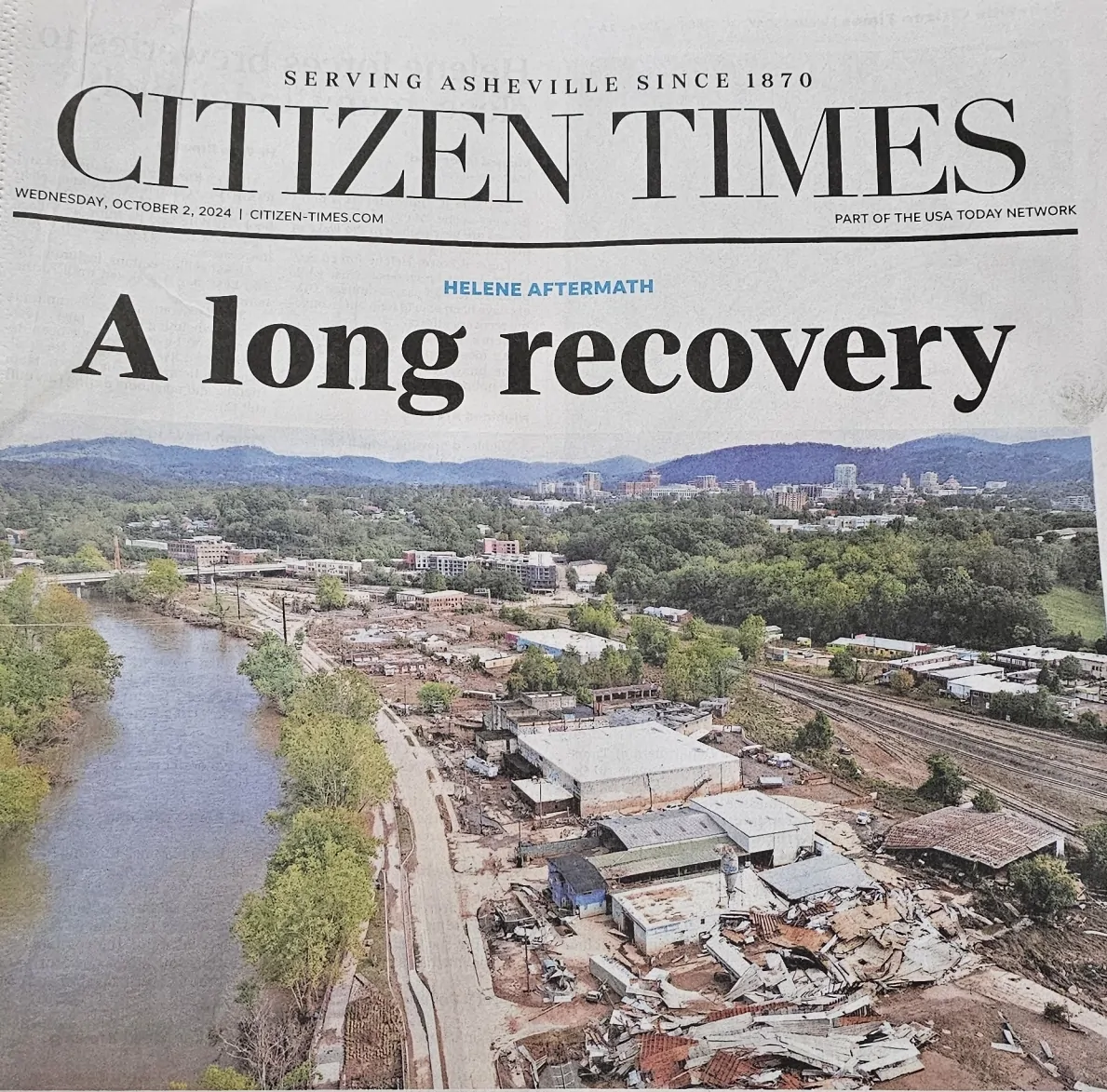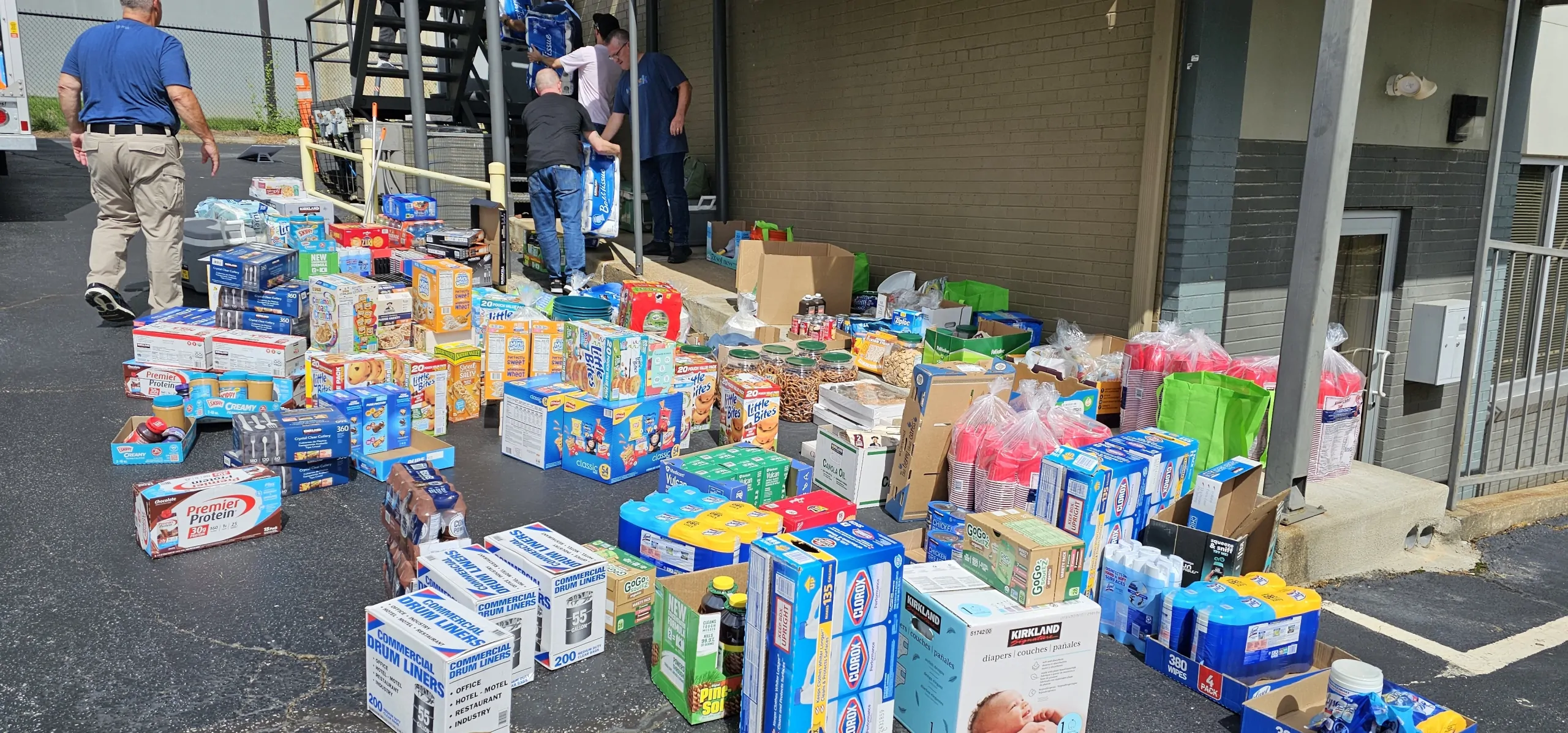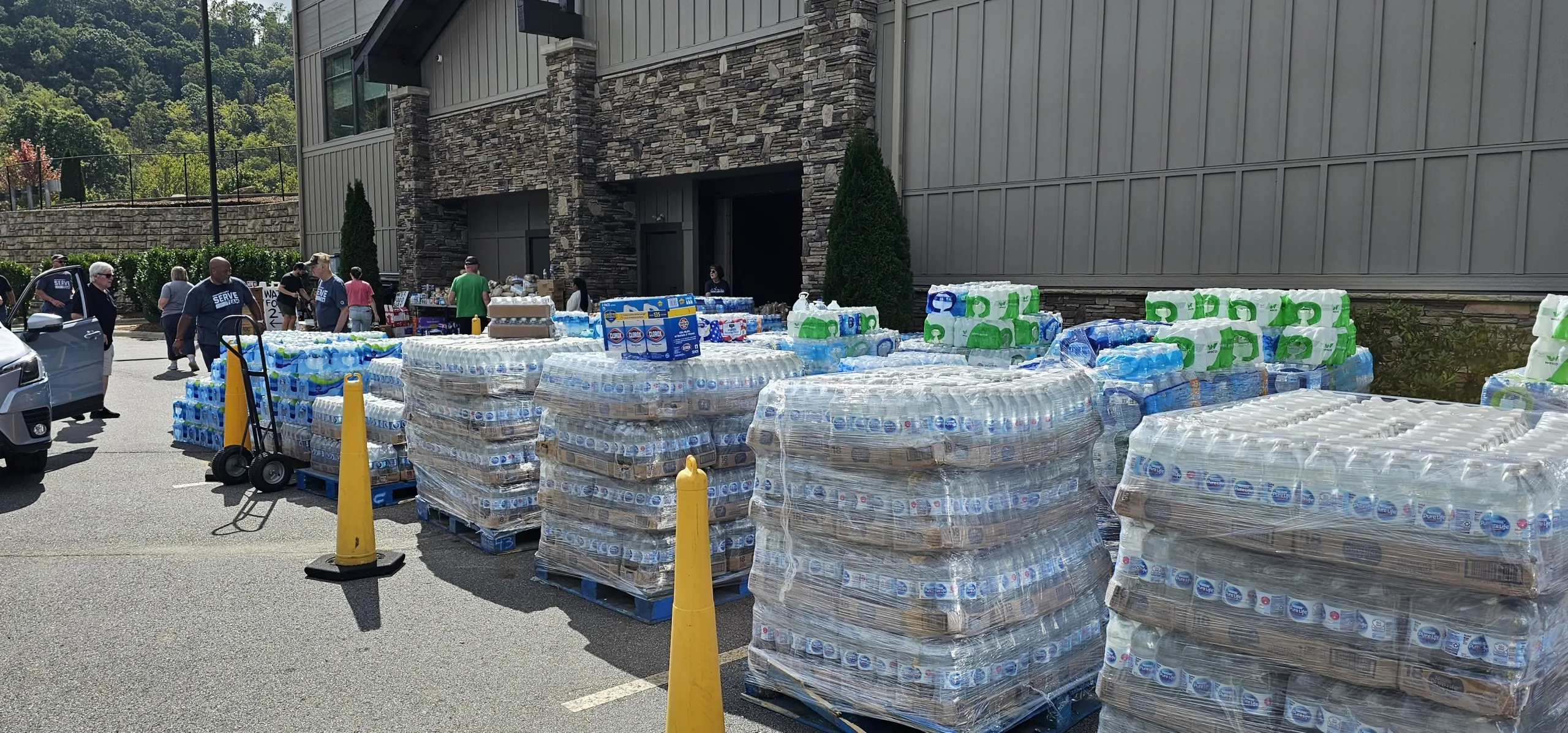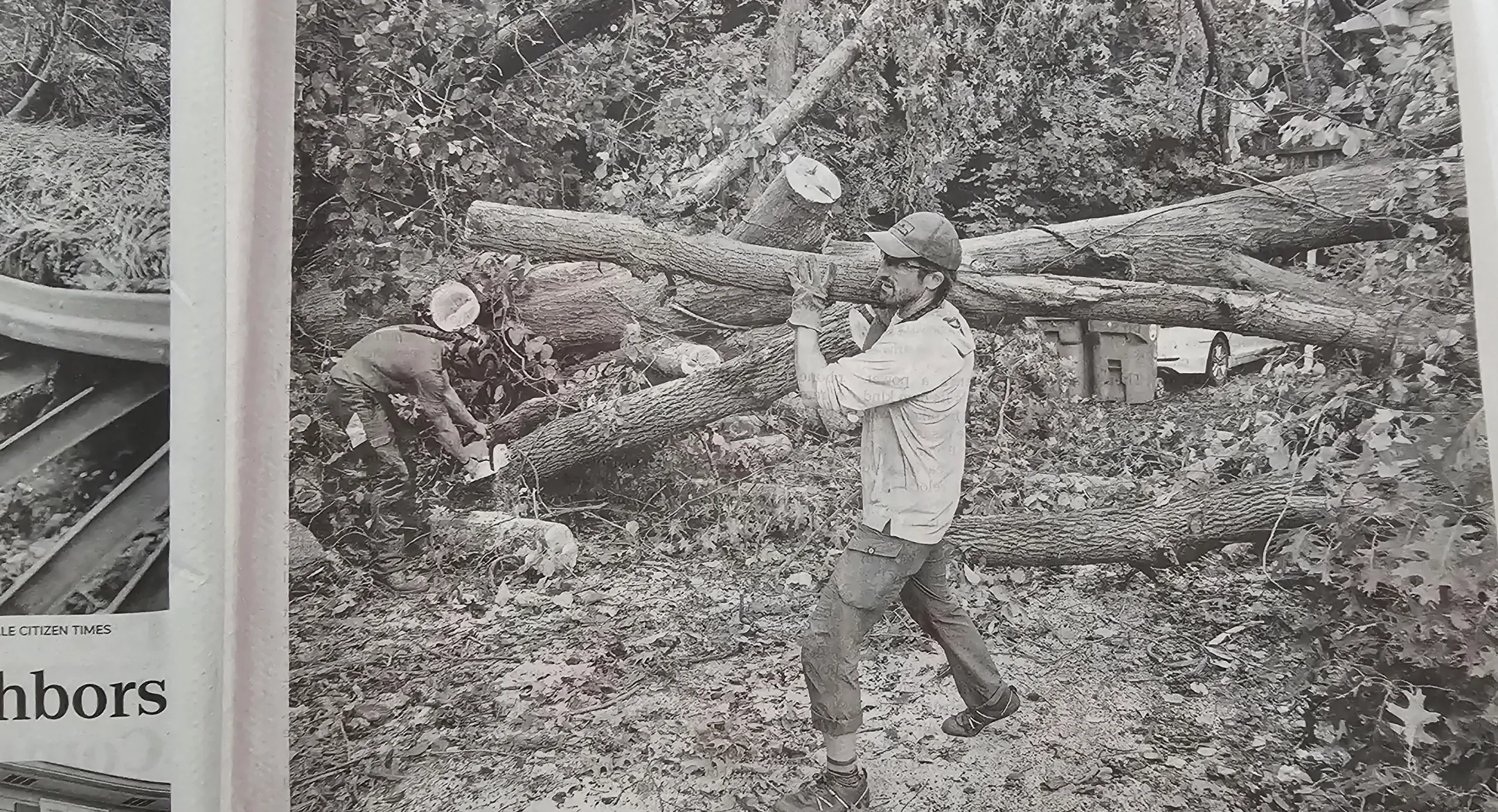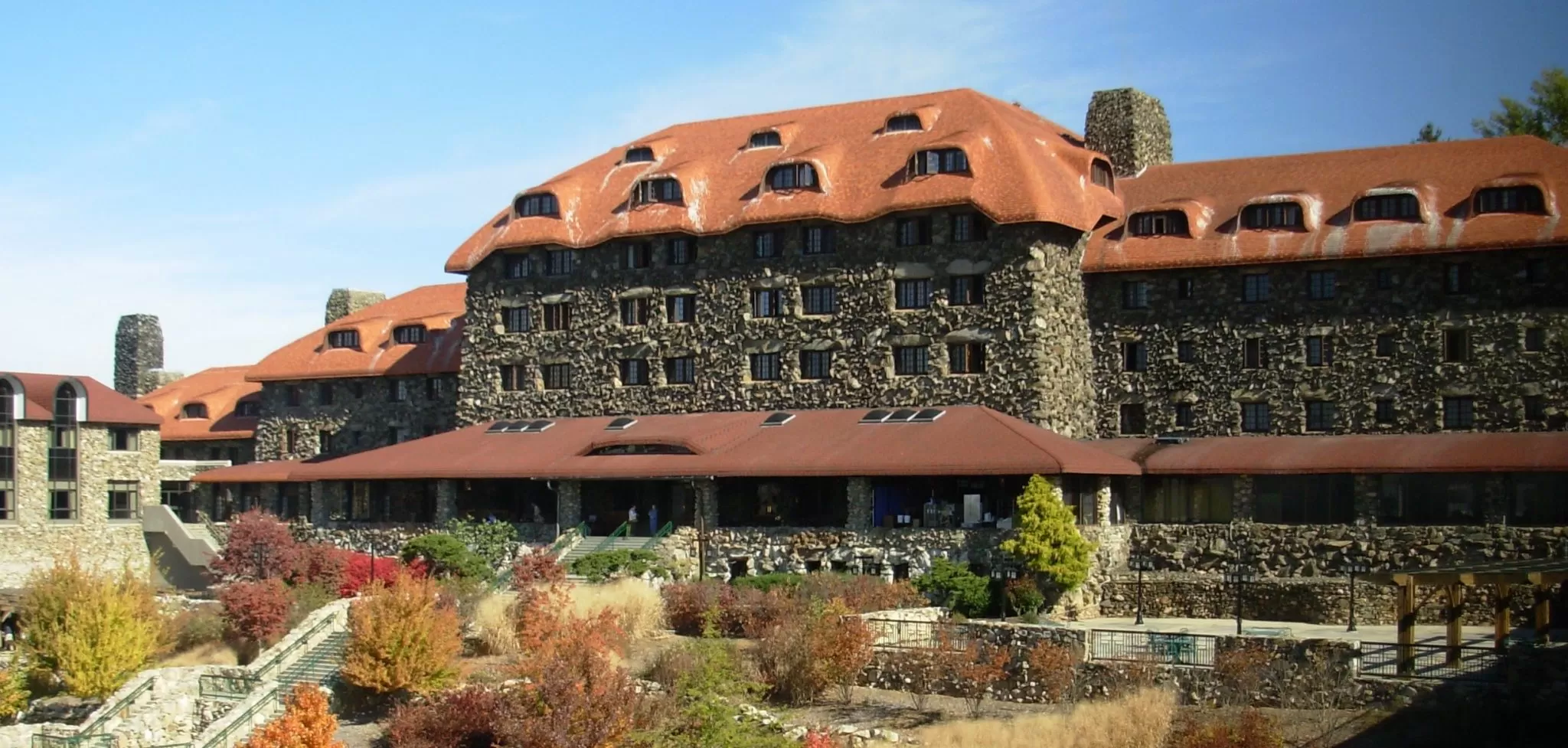Radio and Resilience in Asheville’s Aftermath
by Kate Nixon
Editor’s note: This story is a rare occasion of not covering the American Arts & Crafts Movement or the collecting life. But given that the city of Asheville is beloved by collectors everywhere as the home of the National Arts & Crafts Conference and Shows at the Grove Park Inn and home to many of the people who attend the shows every February, the editor felt the hardworking citizens of Western North Carolina should get their due for their kindness, generosity, and vibrancy of spirit that Asheville is known for.
The front page of my local newspaper The Citizen Times the week after Helene came.
A week and a half ago, my mother told me about a friend who attempted to text her on what the area of Biltmore Village after Tropical Storm Helene passed through. She said, “You can only see the top of the Wendy’s sign peeking through. Everything else was under water.” I knew the exact sign she meant high on a massive pole, but my mind just could not comprehend. My mind rejected it. How could there be such a massive body of water in the street I drove so often? Once I saw the pictures for myself on social media on my phone and in the newspaper, I was just breathless staring at the areas which held such memories for me. Many Asheville citizens did not have reliable cell phone access until several days later – they couldn’t see the horror for themselves until days later. The citizens who lived and worked in the affected areas and in the smaller cities outside Asheville saw it up close and personal. With a rising death count and an exodus of its remaining citizens to other areas with working utilities, Western North Carolina had suffered a devastating blow.
I’ve considered myself an expert at finding the silver lining in situations. I knew it was going to be slim pickings after Helene happened. Until this point, I’ve always liked the phrase “Lord willing and the creek don’t rise.” As you can imagine, it’s now a phrase that will bring up some unfortunate connotations here in Western North Carolina. Asheville was always a river town rich with the natural and a tourist town boasting the French Broad River as part of its tourist attractions. After the uncanny levels of rain delivered by the one-two punch that was Helene and a raging additional storm, the rivers raged and legacy trees crashed onto the roads. Just like that, a vibrant town was muted. But briefly so — in the days following the storm, a remarkable thing happened.
A large UHaul is unloaded with water and supplies from a company based in New Jersey.
Brookstone Church of Weaverville, NC was ready to serve anyone who needed water, food, and diapers.
The media in my life in those couple of weeks – an unreliable phone signal and an emergency radio – began to broadcast and post examples of locals and people from out of state emerging to help. In their honor, I chose to remember a phrase made popular by Mister Rogers: “Look for the helpers.” Based on my observations, I’d alter that to “Look and listen for the helpers.”
Organized helpers came in droves. We know because not only have we seen them, we’ve heard about them on the radio. Instead of looking at our phones (spotty cell signal), Mom and I spent our days and nights listening to our emergency radio station KISS Country FM 99.9. The DJs on this station worked round the clock since last Saturday to connect listeners who can give to those in need, to update folks on road conditions, to inform what gas stations are open and what stores have food and ice, and to report missing family members. Later, our newspaper published a story on how those broadcasters were kept inside by the effects on the storm and answered the calls of so many scared citizens. They never left the station. Listening to the radio became our go-to for connecting with our fellow citizens when we could not leave the neighborhoods. The DJs were makeshift therapists, saying “It’s okay to not be okay.” The recovery for both the businesses and the people of Western North Carolina will be long, but the path is worth enduring in order to get us back to where we were.
The Service Industry Mobilizes in Asheville to help others from The Citizen Times
Hendersonville community members step up to help from Mountain Express
Image from the Citizen Times newspaper of workers moving sections of downed trees from the roads.
Currently, we’re still in clean up mode, but it’s an effort by people all over the south and East Coast even before Asheville made the news.
When I’m not checking in with my local staff to ensure they are safe, I’ve met law enforcement officers, volunteers, county linemen and tree removal service drivers from Georgia, Tennessee, Louisiana, New York and New Jersey clearing the trees from the roads and helping communities. Companies from out of state were buying supplies from Costco and came barrelling down the highway with a massive UHaul to give food, water, generators, batteries, and clothes to people in Asheville. Restaurants in Asheville like Curate (in collaboration with World Central Kitchen), Bears Smokehouse BBQ, and Asiana Market are cooking meals for those in need on the street. The grassroots efforts of the people of Western North Carolina truly brought the vibrancy to match the reputation of this quirky, artsy city. Volunteers and Boy Scout troops at schools and churches filled up jugs of water and loading flats of bottled water with their unlimited caring attitudes, stopping by to ask “How are you? Is everyone in your family ok? Did your house make it through?”
One of Asheville’s main water distribution sites at North Windy Ridge Intermediate school where volunteers and a boy scout troop assisted in providing water, food and supplies to citizens in need.
Western North Carolina will rebuild because we are a resilient people. To this day, every time I go shopping, people still ask each other, “Are you doing ok? You have enough water?” The road will be long and in some cases quite complicated (Asheville’s water system) and it may not immediately look like the beloved Southern oasis built on tourism dollars of just weeks ago. But you’re going to see resilience.
For the local artists who need support, you can use the following resources to support the artists of Western North Carolina.
The River Arts District suffered massive devastation following Helene. Whole entire studios and buildings have been decimated and artists have lost their art, their supplies, and their equipment. They are working to restore their area. Use this link to find out how you can donate: https://www.riverartsdistrict.com/donate/
The Southern Highland Craft Guild has cancelled their activities and shows for the safety of their artists until further notice, including the October Guild Show. Click here to donate to their fund.
The National Coalition for Arts Preparedness and Emergency Response: https://support.southarts.org/campaign/596128/donate
Lastly, I am still moving forward with planning to hold our 2025 Conference at the Omni Grove Park Inn in February. This year’s conference will be a particularly unique opportunity to support all of us in the Arts & Crafts community. While the Grove Park Inn stands on solid ground, it is currently closed waiting to get water services back from the city of Asheville. I will continue to update you on 2025.
Until we meet February 21st – 23rd, thank you for so many messages and encouraging words of support.
“What is the city but its people?” – The Tragedy of Coriolanus, William Shakespeare

